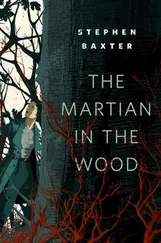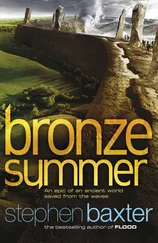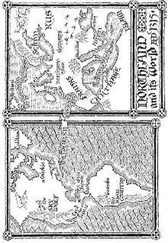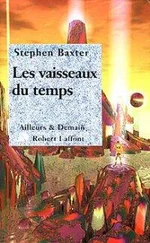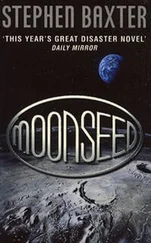The walls were so tall they rose up above the clouds. And they were still visible even at the horizon, as if a notch had been taken out of the very planet.
Thin, high cries fell on her like snowflakes. Peering up, she saw geese flying away from the sun in a vast, crowded formation, skimming through the strip of sky enclosed by the walls. The wall itself was pocked with ledges and pits where birds nested: guillemots, murres, kittiwakes and gulls. The birds flew back and forth against the cliff face, their wings flashing bright against the huge wall’s brooding crimson.
Below the level of this terrace, the steppe-like terrain gave way to a forest of spruce, pine, aspen: cold-resistant trees so tall they seemed to be straining to reach the sky. And beyond them she saw the glimmer of water. It was the canal, the straight-line cut through the Gouge’s deepest part. Alongside the canal more trees grew, but these were fat, water-rich broadleaf trees, oak and elm and maple, basking in the comparative warmth of those depths. She glimpsed a sea of shining black washing along the valley — a herd of migrant animals: bison, reindeer, maybe even horses.
The air over these deeper parts of the Gouge floor shone pink-gold, full of moisture and dust, and the green and blue of water and life overlaid the strong red color of the underlying rock, making a startling contrast. But the thin scraping of life was utterly overwhelmed by the mighty geology that bounded it. And every sound she heard, every rumble that came to her through the ground, was shaped by those tremendous cliffs.
This was a walled world.
Woodsmoke came running floppily before her, his fuzzy-haired head bobbing up and down, his trunk exploring the ground as he ran. "Which way? Which way, Icebones? Which way?"
Icebones peered east, away from the setting sun. Her shadow fled along the ground before her, straight along the Gouge floor, a thing of spindly legs and stretched-out body — just like a native-born mammoth, she thought.
She scratched the calf’s scalp with her trunk fingers. "Follow your shadow, Woodsmoke."
The calf lolloped away, trumpeting his excitement, and his thin cries echoed from the Gouge’s mighty walls.
The Gouge’s floor was carved by lesser valleys and twisting ridges. Lakes pooled, linked by the cruel gash of that central canal. The lakes were crowded with reeds and littered with ducks and geese. Around their shores forests grew, mighty oaks that stretched up so high their upper branches were lost in mist.
The mammoths would come down to the lakes’ gravelly beaches to sip water that was mostly free of salt, even if it fizzed uncomfortably in Icebones’s trunk. But the lower ground was softer and frequently boggy, and nothing grew there but bland uninterrupted grasses, or tall coniferous trees, neither of which provided food that sustained mammoths well. They generally kept to higher ground, where grew a rich mosaic vegetation of grass, herbs, shrubs and trees, providing a healthy diet.
They often glimpsed other animals: Icebones recognized reindeer, horses, bison and musk oxen, lemmings and rabbits, and she saw the spoor of creatures who fed off the grazing herds, like wolves and foxes. The smaller animals seemed about the size she recalled from the Island. But the reindeer and horses were very tall, with spindly legs that scarcely seemed capable of supporting their weight.
The long-legged rabbits could bound spectacularly high into the air. But they fell back with eerie slowness, making them tempting targets for diving raptor birds.
For a while an arctic fox followed the mammoths, sniffing their dung. The fox was in his winter coat, a gleaming white so intense it was almost blue. The fox moved with anxious, purposeful movements over a network of trails, undetectable to Icebones. He was no threat to the mammoths, but the fox was an efficient scavenger of food, a hunter of lemmings and eggs and helpless chicks who might fall from a cliff-side nest. Somehow she found it reassuring to see this familiar rogue prospering in this peculiar landscape.
But still, though the Gouge was crowded with life compared to the upper plains from which they had descended, on the higher ground they passed lakes that had dried up, leaving only bowls of cracked mud. Even here, in this strange walled world, the tide of life was inexorably receding.
Icebones inspected one such mud bowl gloomily. It was churned by many hoof marks, and littered with bits of bone, cracked and scored by the teeth and beaks of scavengers. When the water had vanished, animals, dying of thirst, had congregated here to die — and had then provided easy meat for the predators. She tried to imagine the scenes here as adult jostled with adult, fighting for water, maddened by thirst, and the young and old and weak were pushed aside. And she wondered if any of these bits of well-chewed bone had once belonged to mammoths.
She kept these reflections to herself — but she sensed from Autumn’s reflective silence that the older Cow at least understood this.
But meanwhile the walking was steady, the weather on the Gouge floor calm, the grazing good. The mammoths gradually became more confident, their bellies filling, and the steady rhythms of life banished their lingering grief over the loss of Shoot.
The calf helped, of course.
His scrawny little body filled out, becoming almost burly. His newborn’s hair was growing out, his underfur thicker, his coarser overfur longer. But his hair was still a bright pink-brown, much lighter than that of adult mammoths. He would gallop on stiff legs, leaving an uneven set of clumsy tracks — only to come to a sudden halt, trunk raised to sniff the air, his low forehead wrinkled with concentration. Or he would scoop up loose grass, suck, sniff, blow out dust, and run about as if trying to explore every detail of the ground they crossed. He picked dust and earth and insects from his thickening coat, and with wide-eyed curiosity he would pop each item into his mouth, more often than not spitting it out again.
He was still dependent on his mother’s milk, but Icebones made sure he was happy to be cared for by the others. Spiral, in particular, relished looking after him — so much so, in fact, that Icebones sometimes wondered if she was growing jealous that he wasn’t her own.
Though Icebones never spoke it out loud, all of this was a preparation against the dire possibility that Woodsmoke might lose his mother. No mammoth was more vulnerable than a calf without a mother.
But for now, Woodsmoke was secure and happy, and busy with his exploration of the intriguing world in which he found himself.
One day the calf began to play with a lemming that had, unwisely, not retreated to its burrow as the mammoths’ heavy footfalls approached.
"That lemming is not happy," commented Thunder.
Icebones recalled the Cycle. "No animal likes to be disturbed."
Thunder rumbled deeply. "You often quote your Cycle. But how do you know the Cycle is true?"
She noticed he was walking stiffly. He held his head high. And his legs were stiff, as if sore. Everything about him seemed larger than usual. And, she thought, there was an odd smell about him: something sweet, pervasive, sharp.
He went on, "You didn’t live in the times of long ago when herds of mammoths darkened the steppe. You never met Longtusk or Ganesha or Kilukpuk or any of the rest. Perhaps it is all the murmurings of calves, or foolish old Bulls."
She bridled at that. No mammoth should speak so disrespectfully of the Cycle, the heart of mammoth culture. But then, she reminded herself, Thunder had been brought up in ignorance. It wasn’t his fault, and it was her role to put that right.
Читать дальше

